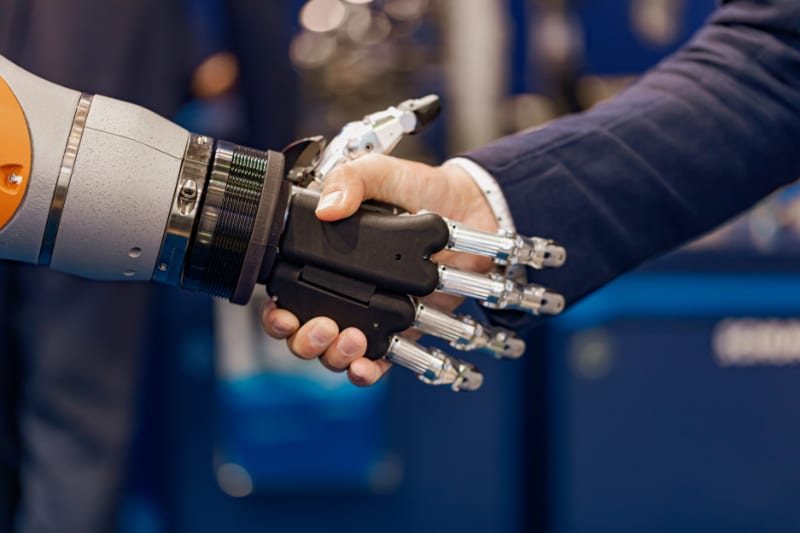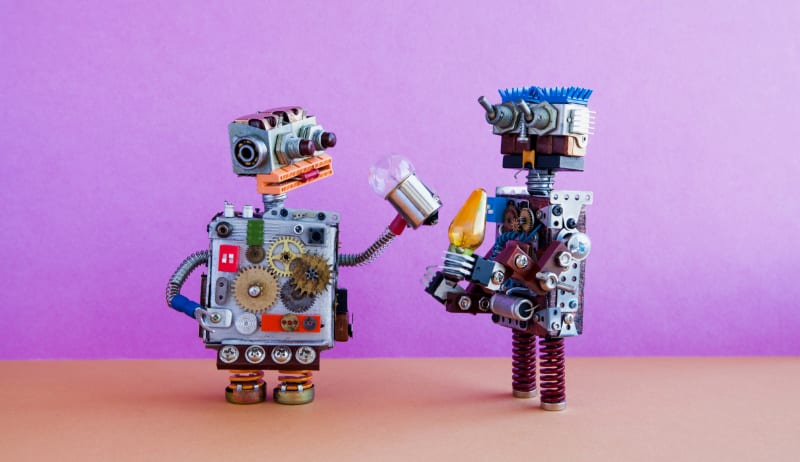In movies and books, artificial intelligence is usually depicted as evil robots and computers taking over the world. But in reality, it’s nothing like that at all. What really is A.I., you may ask? A.I. stands for artificial intelligence. The term was coined in 1956 at a conference at Dartmouth College. A.I. refers to any human-like intelligence that is done by your computer and other machines. Like humans, A.I. learns from examples and experiences. This gives them the ability to solve problems, make decisions, and a variety of other functions.
In this article, you will learn what artificial intelligence is, the different types of artificial intelligence, examples of artificial intelligence in your everyday life, how it works, and why it is so important. Most importantly, you will learn you can use artificial intelligence to help your business.
History of A.I.
- 1 History of A.I.
- 2 Types of Artificial Intelligence
- 3 Examples of Artificial Intelligence
- 4 How Does A.I. Work?
- 5 Why is Artificial Intelligence So Important?
- 6 Artificial Intelligence Tools for Businesses
- 7 FAQs about Artificial Intelligence
- 7.1 1. What companies use artificial intelligence?
- 7.2 2. What are the advantages of artificial intelligence?
- 7.3 3. How did artificial intelligence become what it is today?
- 7.4 4. What is the purpose of artificial intelligence?
- 7.5 5. How can I use A.I. for my business?
- 7.6 6. What’s the difference between narrow AI, general AI, and super AI?
- 7.7 7. Is artificial intelligence safe, and should I be concerned about AI taking over?
Before getting into how A.I. works and the different types of A.I., here’s some brief history of A.I. and how it came to be here today:
1943: Warren McCullough and Walter Pitts published “A Logical Calculus of Ideas Immanent Nervous Activity.”
1949: In Donald Hebb’s book The Organization of Behavior: A Neuropsychological Theory, the Hebbian learning method is developed.
1950: Alan Turing published a ”Computing Machinery and Intelligence” proposing the idea that machines can think.
1952: Arthur Samuel was a computer scientist who developed checkers playing computer games.
1955: The official world of “artificial intelligence” was born.
1958: John McCarthy develops Lisp, a programming language for a.i research.
1963: John McCarthy started the first artificial intelligence program at Stanford University.
1969: The expert system DENDRAL is developed to diagnose blood infections.
1972: The creation of PROLOG
1973: The “Lighthill Report” expressed the disappointments in the research done on A.I this led to cuts to A.I projects.
1974: “The First A.I. Winter” because of the lack of process with A.I. research was stalled and there were no funds available.
After the “First A.I. Winter” things started to look up, Deep Blue was invented, Stanley the self-driving car and speech recognition was developed, and A.I. continues to develop today.
Types of Artificial Intelligence
Different Types of A.I. Based on Their Functionalities:
Reactive Machines
Reactive machines are one of the more basic types of A.I. systems and one of the first stages to an A.I. system. These systems do not have the ability to form memories or use past experiences to make decisions. Reactive machines only react to existing situations, like IBM’s Deep Blue, a chess-playing computer.
Limited Memory
Limited memory means this machine can know by their past experiences because they are able to store data. For example, self-driving cars know when to switch lanes and stop at traffic lights because of the data they save on past experiences.
Theory of Mind
Theory of mind provides the ability to predict and interpret the behavior of others. Although this type of A.I. hasn’t been developed, it has been studied. If this A.I. is ever developed, it will have to understand the thoughts and feelings of others.
Self-Awareness
In the future, A.I wants to advance in building systems so they can form representations about themselves. We are far from creating these self aware A.I systems. First, we need to master being able to fully understand memory, and our own ability to learn about how we learn from our own past experiences.
Different Types of A.I. Based on Their Capabilities:
Narrow A.I
Narrow A.I., also called weak A.I., can only focus on one small task and they can’t perform beyond the small task that they are assigned. It is designed to solve a problem and its main goal is to solve the problem it is commanded to do.
Types of Narrow A.I.
- Siri, Alexa, and Cortana
- IBM’s Waston
- Drone robots
- Email spam filters
General A.I.
General A.I., which sometimes goes by strong A.I., has the ability of learning human tasks. They also are able to use their knowledge and skills they have learned in different situations.
Types of General A.I.
- Quantum computers
Super A.I.
Super A.I. is where A.I. can complete tasks better than humans could themselves. This concept of A.I. is that they can feel emotions, have needs, and desires. This kind of A.I. has not yet been developed. But it might be in the very near future!
Examples of Artificial Intelligence
There are so many products and companies that use A.I. Many of these products are sitting at your home or office right now! They include devices you use daily, including Google searches, digital voice, assistant, and smart home devices.
Netflix
Have you ever wondered how Netflix comes up with your own personal recommendations? They do it with A.I. Netflix uses titles, phases, and your past viewing history to recommend shows and movies you may like. Netflix also uses artificial intelligence for auto-generation and personalization of thumbnails. They utilize thousands of video frames from a movie or a TV show for thumbnail generation. Netflix then uses these images to identify what you would most likely click on to watch.
Google Maps
This software helps you get to your destination, whether it’s a few minutes away or a trip across the country. Google Maps uses AI to monitor real time traffic and weather conditions to accurately give you an arrival time, or to offer you different alternative routes.
Amazon
When you browse a website like Amazon, you will see all kinds of recommendations pop up. For example, you might see something like: “We picked out these other items you might like!” Amazon delivers these recommendations by learning what you like and what products other people like you have purchased.
Siri
People use Siri and other digital voice assistants every day. They tell you the weather, assist you in answering a text message, or play you a song on command. These digital voice assistants use natural language processing and generators to answer your commands and assist you.
Facebook, Twitter, and Instagram
Even your favorite social media platforms use artificial intelligence. A.I helps filter your feed based on what types or posts you like based on your history. A.I also helps with who shows up in your friends’ suggestions.
How Does A.I. Work?
Artificial intelligence works by combining data and processing algorithms, allowing software to be able to learn patterns in data and many applications go hand-and-hand with artificial Intelligence to make it function.
Machine learning
Machine learning is an application of A.I that provides computer systems with the ability to learn from past experiences without being programmed. It can analyze data and make predictions from it.
Deep learning
Deep Learning uses neural networks which are algorithms that mimic operations of the human brain to recognize relationships between data. With advances in computing power and training techniques, it allows learning patterns in large amounts of data.
Cognitive computing
Cognitive computing’s purpose is to improve interaction between us and machines. It seeks to mimic human processes, but in a computer model.
NLP
Natural Language Processing, which stands for NLP, allows computers to recognize and interpret. This gives computers the ability to communicate and produce speech.
Computer Vision
This allows the interpretation of an image by pattern identification and deep learning. Computer vision can intercept graphs, tables, and other documents.
Why is Artificial Intelligence So Important?
Why is artificial intelligence so important? It is altering business, industries, everyday life as we speak! Artificial intelligence has the ability to collect data that can be used to drive marketing decisions and overall improve businesses. A.I has helped manage global supply chains to determine better delivery routes, increase productivity, to customer service.
Many bigger companies use artificial intelligence to their advantage to improve their businesses. Here are just some of them and there are many more companies that use A.I.!
- IBM
- Microsoft
- Spotify
- Under Armour
Artificial Intelligence Tools for Businesses
Artificial intelligence can help small businesses in all sorts of ways, from customer service to cybersecurity to helping you learn about your company’s customers. CRM software is one of the ways A.I. can help a business. CRM can learn about customers from their past orders. For example, if a customer frequently buys a product, CRM can send them emails or promotions about that certain product.
Cybersecurity is also another application of A.I. A.I. security can look for unusual activity and also spot other irregularities in systems like illegal activity. Need 24/7 customer service on your website? A.I can help with that. Artificial intelligence can help customers by anticipating what the customers need and deciding if they need human help. It also helps personally in the workplace. Artificial intelligence can do simple and tedious tasks for you, so you can use your valuable time in other areas.
Reach out to SEO Design Chicago today if you have any questions, comments, or concerns regarding using artificial intelligence in your business.
FAQs about Artificial Intelligence
1. What companies use artificial intelligence?
Many major companies across various industries use AI extensively. Tech giants like IBM, Microsoft, Google, Amazon, and Facebook integrate AI into their core products and services. Entertainment companies like Netflix and Spotify use AI for personalized recommendations. Retail companies like Amazon use AI for product suggestions and supply chain optimization. Even traditional companies like Under Armour use AI for performance analytics. Today, AI is used across industries including healthcare, finance, automotive, retail, and manufacturing, with both large corporations and small businesses finding ways to leverage AI tools.
2. What are the advantages of artificial intelligence?
AI offers numerous advantages including increased efficiency and productivity by automating repetitive tasks, improved decision-making through data analysis and pattern recognition, 24/7 availability for customer service and support, enhanced personalization for customer experiences, better accuracy in tasks like fraud detection and medical diagnosis, cost reduction through automation, and the ability to process vast amounts of data quickly. For businesses, AI can help with everything from customer relationship management and cybersecurity to supply chain optimization and marketing insights.
3. How did artificial intelligence become what it is today?
AI development has been a gradual process spanning decades. It began with theoretical foundations in the 1940s-1950s, including Alan Turing’s work on machine thinking and the coining of “artificial intelligence” in 1956. Early developments included programming languages like Lisp and expert systems like DENDRAL. After experiencing “AI winters” with reduced funding and interest, AI resurged with advances in computing power, the development of machine learning algorithms, and the creation of systems like IBM’s Deep Blue. Today’s AI capabilities are built on decades of research in neural networks, deep learning, and natural language processing, combined with massive increases in data availability and computational power.
4. What is the purpose of artificial intelligence?
The primary purpose of AI is to create machines that can perform tasks that typically require human intelligence, such as learning, reasoning, problem-solving, and decision-making. AI aims to augment human capabilities rather than replace humans entirely. Its goals include automating repetitive tasks to free up human time for more creative work, improving accuracy and efficiency in various processes, enhancing our ability to analyze and understand complex data, providing personalized experiences and recommendations, and solving complex problems that might be difficult for humans to handle alone.
5. How can I use A.I. for my business?
Small businesses can implement AI in several practical ways: use CRM software with AI capabilities to better understand customer behavior and send personalized promotions, implement AI-powered chatbots for 24/7 customer service, utilize AI for cybersecurity to detect unusual activity and protect against threats, employ AI tools for data analysis to make better business decisions, use AI for inventory management and supply chain optimization, implement AI-powered marketing tools for better targeting and personalization, and automate routine tasks like scheduling, email responses, and data entry to save time and reduce costs.
6. What’s the difference between narrow AI, general AI, and super AI?
These represent different levels of AI capability. Narrow AI (or weak AI) can only perform specific, limited tasks – like Siri answering questions or Netflix making recommendations. This is the only type of AI that currently exists. General AI (or strong AI) would have human-level intelligence across all domains, able to learn and apply knowledge to any situation just like humans do. Super AI would surpass human intelligence in all areas, potentially having emotions, needs, and desires. Neither general AI nor super AI have been developed yet, though they remain long-term goals in AI research.
7. Is artificial intelligence safe, and should I be concerned about AI taking over?
Current AI systems are narrow and designed for specific tasks, so they pose no threat of “taking over.” Most AI safety concerns today focus on practical issues like data privacy, algorithmic bias, and job displacement in certain sectors. However, AI is generally safe when properly developed and implemented with appropriate safeguards. The dramatic portrayals of AI in movies are far from current reality. Instead of fearing AI, focus on understanding how to use it responsibly and ethically in your business and daily life. As AI continues to advance, ongoing research into AI safety and ethics helps ensure beneficial outcomes for society.








Contact Us today!